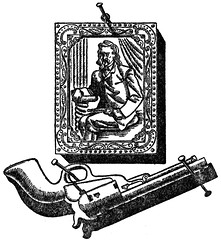Well, I don’t suppose I’ll have another opportunity to make two tintype-related posts in a row, so I’ll take it. I’ve got a little book on my shelf, Tintypes In Gold, by Joseph Henry Jackson (1939). It tells the (non-fiction) stories of four California highwaymen of the gold rush era: Black Bart, Rattlesnake Dick, Dick Fellows and Tom Bell. I bought it because it contains ‘decorations by Giacomo Patri’. Patri also published, in the same year, White Collar – a fantastic wordless novel in linocuts, in the Lynd Ward mold. I think it’s better than anything Ward did. Anyway, I was curious about Tintypes. And now I’ve made a little Flickr set so anyone else who is curious (or a Patri completist) can see as well.
Nothing so special, it turns out. Given the subject matter, I was hoping for something wild and amazing. But I see someone has the entirety of White Collar online (but only in miniature). Also, here’s a nice little bio piece.
In 1939, [Patri] published what many consider his masterpiece, the wordless graphic novel White Collar. Largely autobiographical, the central character is an illustrator whose family becomes homeless. Patri felt that the economic crises of the Great Depression, disillusionment with capitalism and the possibilities of labor union fellowship made the book necessary. Patri describes how the book began, “One day a friend handed me a paper proclaiming a solution to the all-pervasive social and economic problems. Naturally I became very excited. I wanted to be part of a movement that promised to solve our desperate situation… When the NRA appeared on the scene under the aegis of the New Deal, many white collar workers objected strenuously to any attempts to organize into labor unions. Hence, White Collar.” Engraving, printing, binding and distributing the book with help from his wife Stella and his young sons Piero and Remo took several years. A new edition of the book was published in 1975.
What makes it truly great is the nightmarish, expressionistic yet clean-lined quality:
You can pick up one of the original, limited first edition handmade copies of White Collar for a mere $2750. A more sensible option might be to get it together with others in Graphic Witness: Four Wordless Graphic Novels by Frans Masereel, Lynd Ward, Giacomo Patri and Laurence Hyde [amazon].
While I’m still on the subject of exotically antique printing methods, and overpriced stuff you can get from Abebooks, let me just tell Santa that – if he has $4500 burning a hole in his pocket – I would not look askance at a copy of Moths and Butterflies of the United States, East of the Rocky Mountains (1900), by Sherman Denton. Quoting from the book listing: “The plates in this book are direct transfers from the insects themselves; the scales of the wings of the insects are transferred to the paper while the bodies are printed from engravings and afterward colored by hand, fixing their colors and iridescences as in life.” The book is kinda legendary, I guess. Though the listing adds that there is nothing – nothing! – distinctly American about this. The French did it first! This mysteriously direct, insectography print process. (I would have assumed it was a fictional element of a Nabokov novel.) Did this process require the destruction of one butterfly/moth per page per copy? Is part of the butterfly actually on the paper after the process is complete? If so, then it’s curiously auto-iconic. Well, I guess I’ll just hope Santa brings me an iPad instead. That seems more likely.
What’s on your book wish list that you aren’t going to get?

